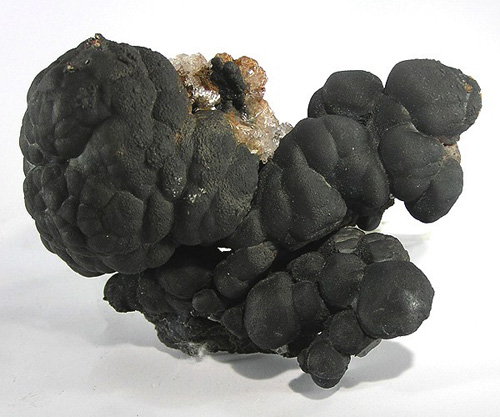The Mineral goethite

Goethite is a common mineral, and is a frequent matrix material for other more aesthetic minerals. It is usually a dark, uninteresting mineral, though specimens from a handful of locations (especially Colorado) are remarkable for their delicate and beautiful crystal growths and velvety botryoidal growths. Goethite is also frequent as black crystal sprays that form within geodes on drusy Quartz. It commonly forms a pseudomorph after other minerals, especially Marcasite, Pyrite, Siderite, and Gypsum.
Goethite is named after Johann Wolfgang von Goethe (1749-1832), the famed German poet, philosopher, biologist, and mineral enthusiast.
Color
Black, brown, yellowish-brown, reddish-brown, yellow. May be iridescent with a multicolored rainbow-like display of darker toned colors. Rarely banded.
Crystal System
Orthorhombic
Uses
Goethite is used as an ore of iron.
Noteworthy Localities
Goethite is found throughout the world, though collection-worthy specimens are less common. Branching stalactites and botryoidal masses, often associated with bright contrasting Vanadinite, come from the Four Man Mine, Taouz, Morocco. Recent finds of branching Goethite pseudomorphs after Marcasite are exceptional at the Farfara Oasis, in the White Desert of Egypt. Rainbow-like iridescent Goethite coating sandstone was found in the Munday's Hill Quarry, Leighton Buzzard, England; and highly iridescent growths come from Tharsis, Alosno, Spain. Sharp bladed crystals come from Chaillac, Indre, France.
Fascinating, elongated pseudomorphs of Goethite after Gypsum were found in Santa Eulalia, Chihuahua, Mexico; and rounded Goethite balls have come from Wawa, Ontario, Canada.
In the U.S., exceptionally pretty acicular Goethite crystals with a sharp luster are found at the Crystal Peak and Lake George areas, Park and Teller Cos., Colorado. Perfectly crystallized Goethite pseudomorphs after Pyrite come from Pelican Point, Utah Co., Utah; and attractive botryoidal forms were found in the famous Copper Queen Mine, Bisbee, Cochise Co., Arizona. Large deposits of Goethite can be found in Michigan in the Menominee iron range, Iron Co.; and in the Marquette iron range, Marquette Co. A highly iridescent Goethite is well-known from Graves Mountain, Lincoln Co., Georgia. Large botryoidal plates and clusters can be found in Oreland, Montgomery Co., Pennsylvania.
Distingushing Similar Minerals
Hematite - Has a reddish-brown streak, heavier, and usually more metallic lustered.
Limonite - Lacks definitive crystal structure.